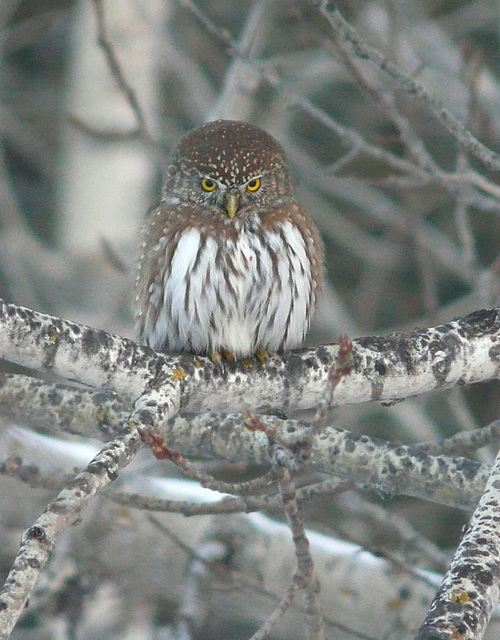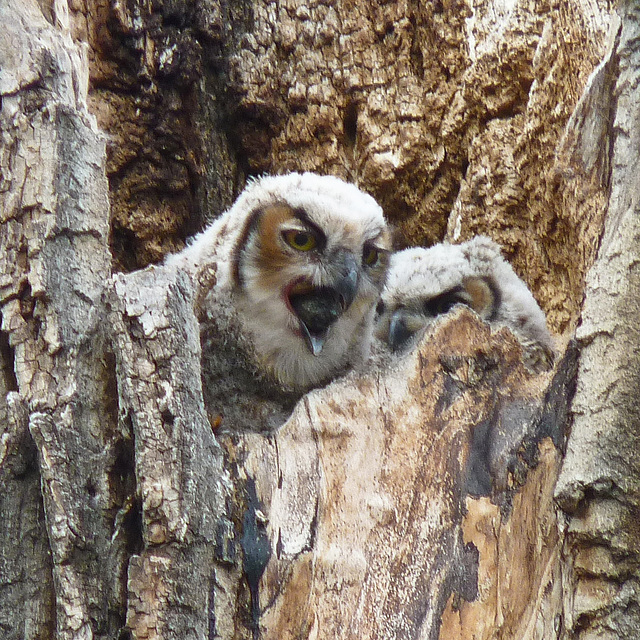
Fish Creek Park 1
I accidentally deleted my original Fish Creek Park set (on 20th June 2011) - the 1021 images in it were NOT deleted from my photostream, just the set - so I will now have to add them all to this new set. I tried batch adding using tags, but it just wouldn't work, so I guess I will have to add each photo individually. Maybe it couldn't handle 1021 images in one go?
Wordless communication
A little Red-breasted Nuthatch on someone's hand, at Bebo Grove, Fish Creek Park. I love having one of these fly down - they are so small and lightweight - but fast! This is a little male, as he has a darker red breast and a black cap, compared to the grey cap of the female.
23 Jun 2011
Wolf Willow
The beautiful, tiny yellow flowers are out in full bloom on the Wolf Willows/Silverberries at the moment. The shrubs give off such a powerful, musky-sweet scent - people either love it or hate it, ha. I'm one of the ones who loves it. Photographed these at Votier's Flats, Fish Creek Park, yesterday, while on a three-hour walk.
17 Apr 2010
Fish Creek Park displays
Living in Calgary, we are so lucky to have Fish Creek Provincial Park, which is one of the largest urban parks in North America and more or less goes from the far west to the far eastern edge of the city.. The park contains areas of mixed forest and open prairie, so we get a good variety of species.
Friends showed me around inside the newly renovated Fish Creek Environmental Learning Centre during their Open House a few days ago. There are several of these huge wall posters in various rooms. Each is a flat poster with a wooden frame over the top, to make one feel as if one is looking through the window to the beautiful park outside. Several of my photos appear on these posters, though the Merlin (lower right) is the only one on this particular poster. Very nicely done. I always like knowing that images are being used for educational purposes.
We walked along the Bow River south of 22X (northwards from 194th Avenue SW) all morning. Saw my first Cinnamon Teal and Tree Swallow of the year : ) Called in to see the Great Horned Owlets on the way home, and then went and vacuumed and washed my vehicle so that it's fit to go for an oil change in the next week. Quite a hot, sunny day today - just gorgeous weather (it's supposed to be spring, not summer) - but it is about to change, LOL. Of course - I've got a lovely clean car! Some people perform a Rain Dance - I don't need to, I just wash my car, ha, ha.
14 Aug 2007
Osprey eating fish
Another photo of the Osprey that I saw two days ago, in the Glennfield area of Fish Creek Park. Here, it is busy eating a fish that it had caught.
20 Aug 2007
Katydid up close
We saw this Katydid in Burnsmead, Fish Creek Park, the other day. Amazingly difficult not only to see amongst all the green leaves, but also to photograph. It looked just like a tiny leaf itself!
"The family Tettigoniidae, known in American English as katydids and in British English as bush-crickets, contains more than 6,400 species. It is part of the suborder Ensifera and the only family in the superfamily Tettigonoidea. They are also known as long-horned grasshoppers, although they are more closely related to crickets than to grasshoppers.
Tettigoniids may be distinguished from grasshoppers by the length of their antennae, which may exceed their own body length, while in grasshoppers are always relatively short.
The name "katydid" comes from the sound produced by species of the North American genus Pterophylla (literally "winged leaf"). The males of katydids have sound-producing organs (via stridulation) located on the hind angles of their front wings, which in some species produce a sound thought to resemble the words "Katy did, Katy didn't", hence the name. In some species females are also capable of stridulation.
There are about 255 species in North America, but the majority of species live in the tropical regions of the world.
The diet of tettigoniids includes leaves, flowers, bark, and seeds, but many species are exclusively predatory, feeding on other insects, snails or even small vertebrates such as snakes and lizards. Some are also considered pests by commercial crop growers and are sprayed to limit growth." From Wikipedia.
09 Dec 2008
Me and my crazy friends
I was out in Fish Creek Park with a few friends yesterday morning, enjoying a walk in this winter wonderfland. We don't usually have the snow stay on the trees like this, so it was a beautiful treat for one day. I think it was about -9C; it's supposed to be -21C this weekend - then we will be crazier than ever, LOL! Like Rebecca (Red~Star), I love a bright splash of red in a snowy, winter photo. I did thank my friend for wearing red : )
14 May 2008
Thorny Buffaloberry
This shrub is growing in Fish Creek Park, at Votier's Flats. Also saw another one at Inglewood Bird Sanctuary. It looks very similar to Canada Buffaloberry. Tiny (about 4 mm across), brownish yellow flowers, no petals, only 4 sepals. This photgraph shows a male specimen, as it has 8 stamens per flower.
"Shepherdia argentea (Silver Buffaloberry or Bull berry, thorny buffaloberry) is a species of Shepherdia, native to central North America from southern Canada (Alberta, Saskatchewan, Manitoba) south in the United States to northern California and New Mexico.
It is a deciduous shrub growing to 2-6 m tall. The leaves are arranged in opposite pairs (rarely alternately arranged), 2-6 cm long, oval with a rounded apex, green with a covering of fine silvery, silky hairs, more densely silvery below than above. The flowers are pale yellow, with four sepals and no petals. The fruit is a bright red fleshy drupe 5 mm in diameter; it is edible but with a rather bitter taste.[2]
The berry is one of the mainstays of the diet of the Sharp-tailed Grouse, the provincial bird of Saskatchewan.
The plant contains a low concentration of tetrahydroharmol, which acts as a psychedelic drug in high enough doses." From Wikipedia.
06 Dec 2007
The Owl Lady strikes again!
I went back to Bebo Grove, Fish Creek Park, this afternoon. Found the rare Black-backed Woodpecker again immediately. Then I walked back towards the parking lot to photograph a group of five Mule Deer. Noticed two gentlemen with their enormous lenses focussed on "something". They said they had found a tiny Northern Pygmy-owl. These owls are rare to uncommon year-round in Alberta. Think I've only ever seen one twice in the city and once in the mountains. They can be mobbed by little songbirds and the owls have a pair of "false eyes" on the back of their head to help intimidate these songbirds, such as Chickadees. Though Pygmy-owls are small, they are fierce and often catch birds that outweigh themselves. They usually feed at night, but we did see this little guy swoop a few times this afternoon. They are such cute little owls to look at ! Only 18 cm long and about the size of a person's fist or a popcan. I'm surprised that any of my photos came out as the sky was clouding over and I was looking into the trees. Extremely "noisy" shots but I'm still so happy to have them!
Coughing up a pellet
A couple of evenings ago, when I was watching the Great Horned Owl family in Fish Creek Park, one of the owlets coughed up a pellet. However, instead of spitting it out, it swallowed it again, then coughed it up again, swallow, and so on, over and over again, LOL. I don't think I've ever captured a pellet being coughed up before. I also captured some funny expressions while it was doing this, with its face all screwed up, but it makes the face take on an almost human look, which was a little creepy. After a long morning walk at Carburn Park today, I called in to see "my" owls and then took just a short walk and found another pair of Great Horned Owls that I had been told about. Saw two adults but no sign of any young ones. Warning: this is a VERY heavily cropped image, so don't bother looking at large size, LOL.
"A pellet, in ornithology, is the mass of undigested parts of a bird's food that some bird species occasionally regurgitate. The contents of a bird's pellet depend on its diet, but can include the exoskeletons of insects, indigestible plant matter, bones, fur, feathers, bills, claws, and teeth .... Hawk and owl pellets are grey or brown, and range in shape from spherical to oblong or plug-shaped. In large birds, they are one to two inches long .... The hair, bones and other body parts (such as limbs, skin fragments, and even faeces) of rodents found in owl pellets may carry viable rodent viruses and bacteria. It is therefore advisable to sterilize pellets in a microwave oven before study. This is particularly important when using pellets at school." en.wikipedia.org/wiki/Pellet_(ornithology)
Jump to top
RSS feed- Latest items - Subscribe to the latest items added to this album
- ipernity © 2007-2025
- Help & Contact
|
Club news
|
About ipernity
|
History |
ipernity Club & Prices |
Guide of good conduct
Donate | Group guidelines | Privacy policy | Terms of use | Statutes | In memoria -
Facebook
Twitter










